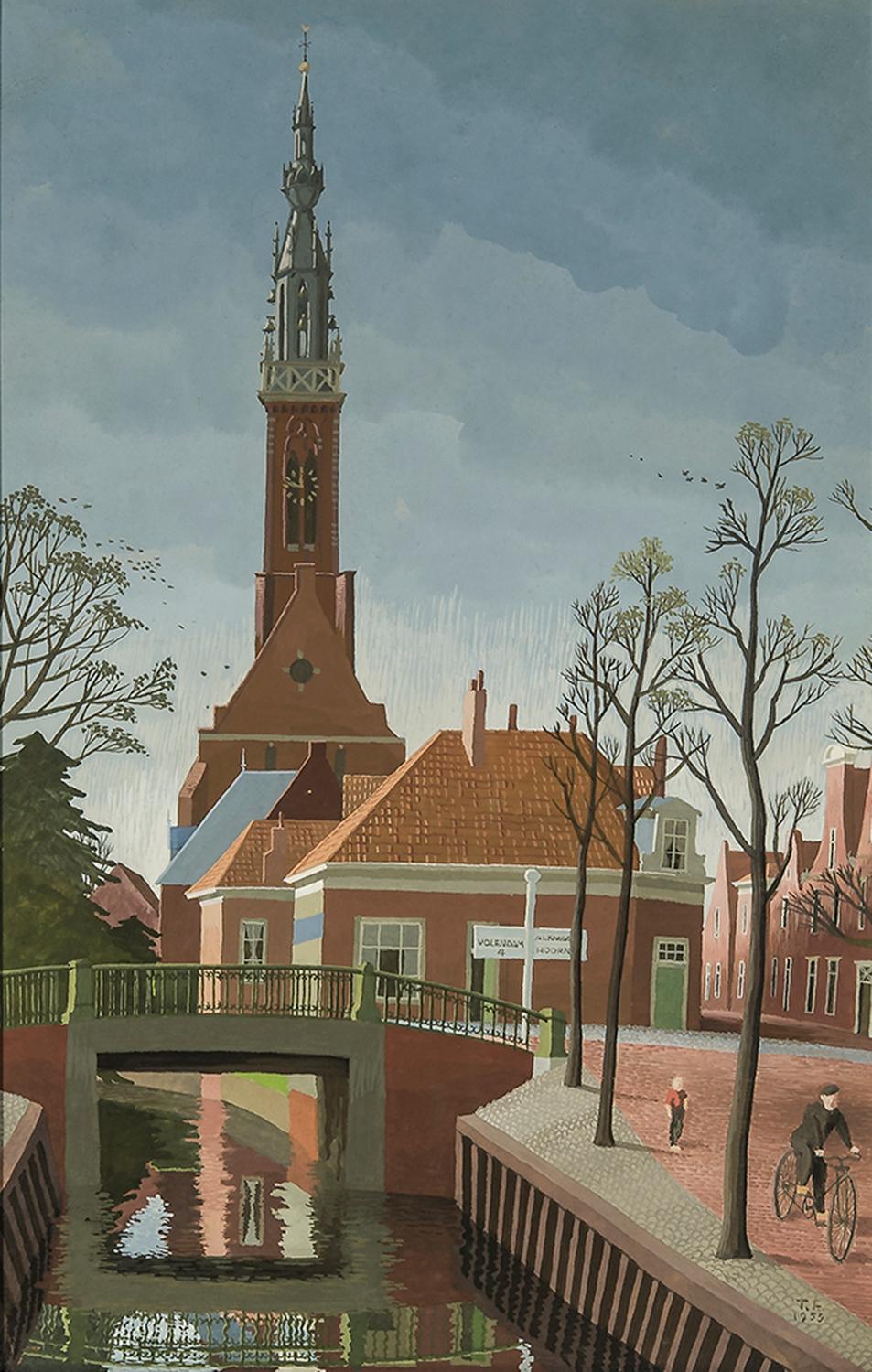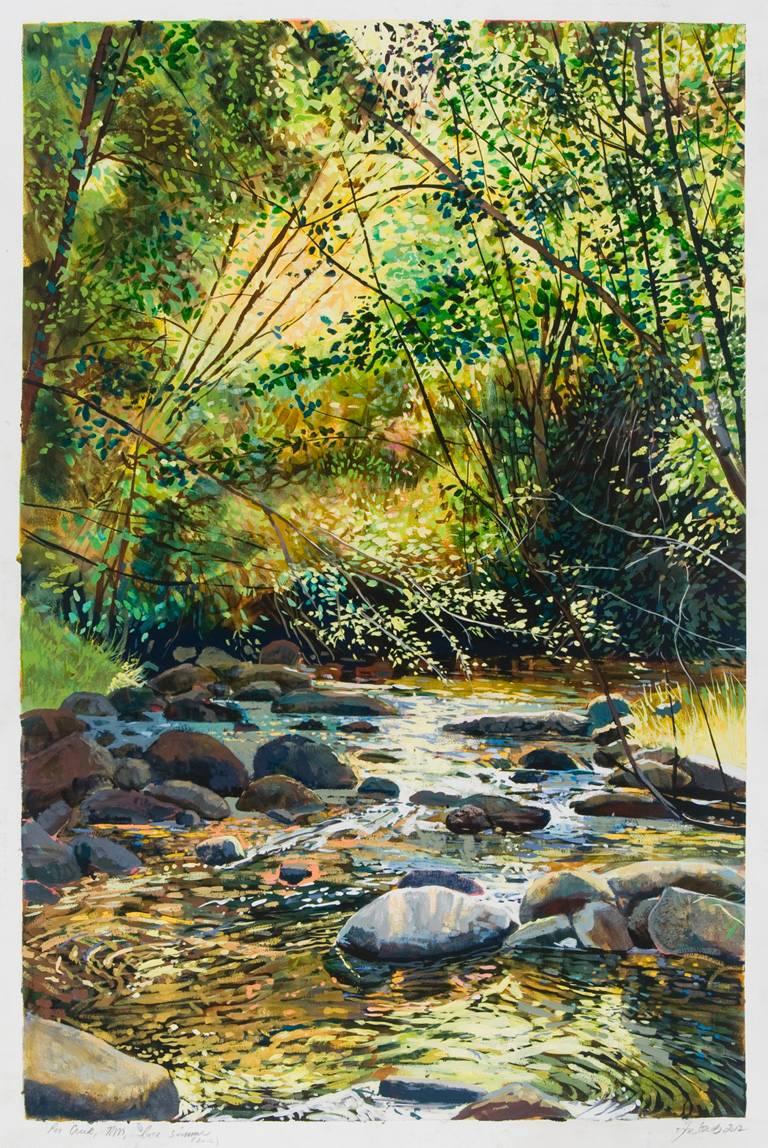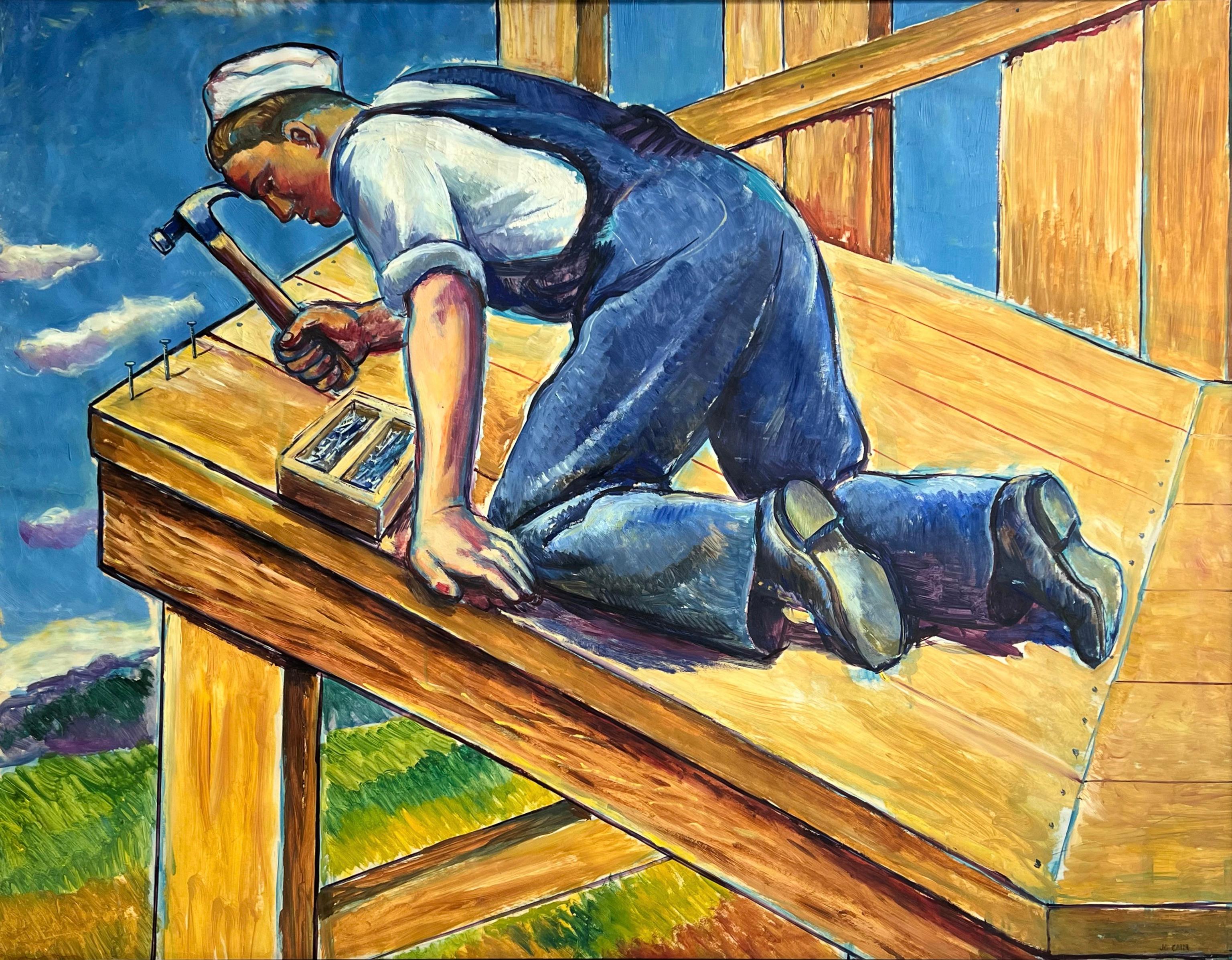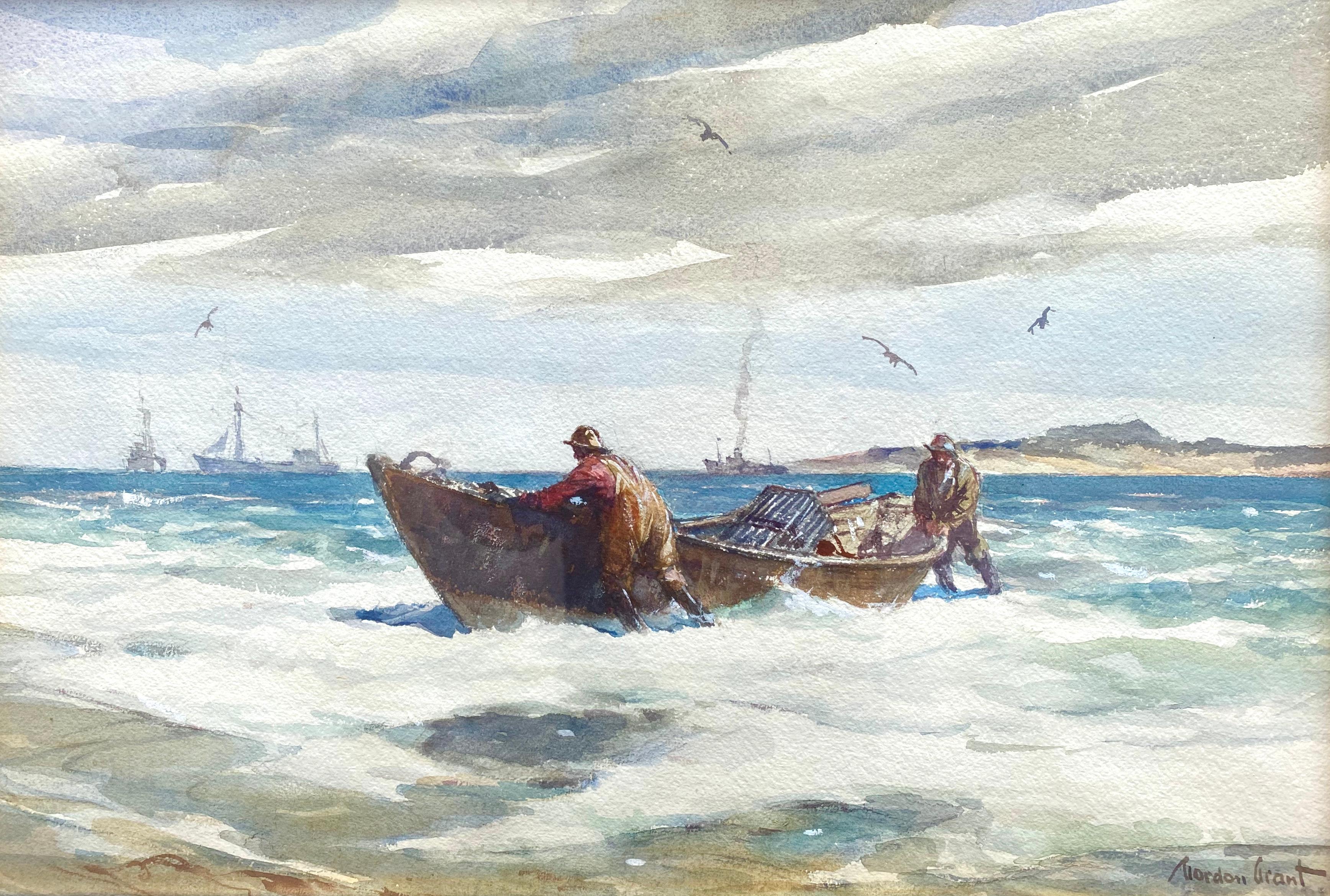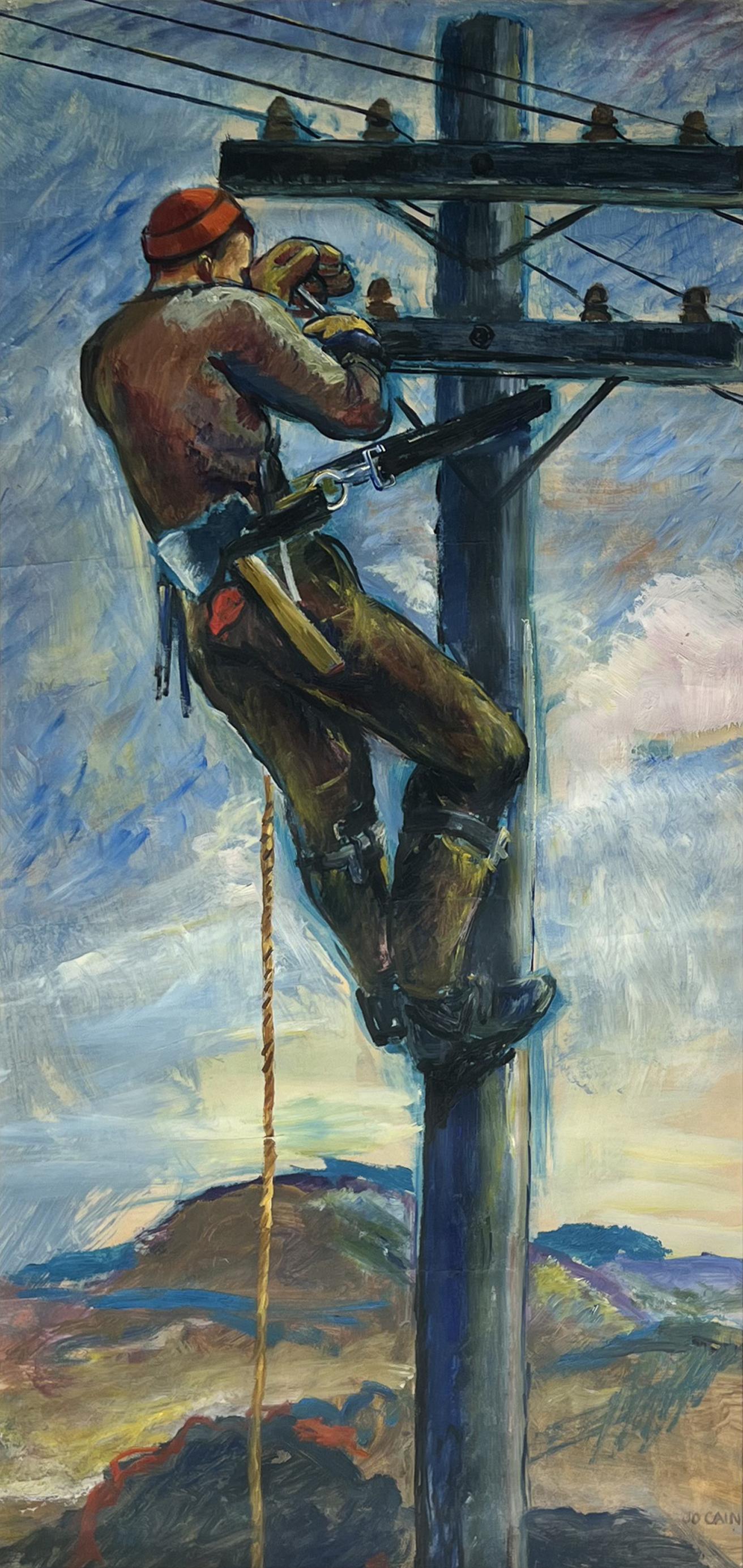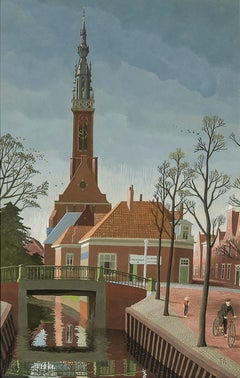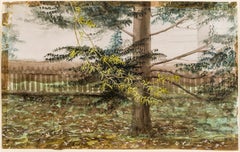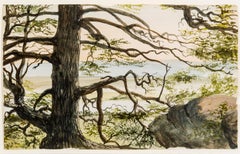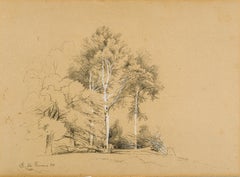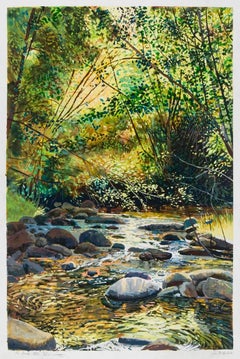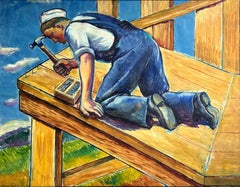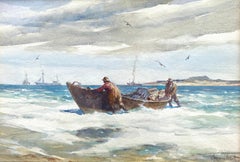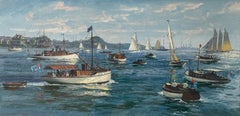Items Similar to Passaic Falls in New Jersey
Want more images or videos?
Request additional images or videos from the seller
1 of 5
Nicolino V. CalyoPassaic Falls in New Jersey
About the Item
Nicolino Calyo's career reflects a restless spirit of enterprise and adventure. Descended in the line of the Viscontes di Calyo of Calabria, the artist was the son of a Neapolitan army officer. (For a brief biographical sketch of the artist see Philadelphia Museum of Art, Pennsylvania, Philadelphia: Three Centuries of American Art, exhib. cat. [1976], pp. 299-301 no. 257.) Calyo received formal training in art at the Naples Academy. His career took shape amidst the backdrop of the political turbulence of early nineteenth-century Italy, Spain, and France. He fled Naples after choosing the losing side in struggles of 1820-21, and, by 1829, was part of a community of Italian exiles in Malta. This was the keynote of a peripatetic life that saw the artist travel through Europe, to America, to Europe again, and back to America.
Paradoxically, Calyo’s stock-in-trade was close observation of people and places, meticulously rendered in the precise topographical tradition of his fellow countrymen, the eighteenth-century
vedute painters Antonio Canale (called Canaletto) and Francesco Guardi. In search of artistic opportunity and in pursuit of a living, Calyo left Malta, and, by 1834, was in Baltimore, Maryland. He advertised his skills in the April 16, 1835 edition of the Baltimore American, offering "remarkable views executed from drawings taken on the spot by himself, . . . in which no pains or any resource of his art has been neglected, to render them accurate in every particular" (as quoted in The Art Gallery and The Gallery of the School of Architecture, University of Maryland, College Park, 350 Years of Art & Architecture in Maryland, exhib. cat. [1984], p. 35). Favoring gouache on paper as his medium, Calyo rendered faithful visual images of familiar locales executed with a degree of skill and polish that was second nature for European academically-trained artists. Indeed, it was the search for this graceful fluency that made American artists eager to travel to Europe and that led American patrons to seek out the works of ambitious newcomers.
On June 16, 1835, the Baltimore Republican reported that Calyo was on his way north to Philadelphia and New York to paint views of those cities. Calyo arrived in New York, by way of Philadelphia, just in time for the great fire of December 1835, which destroyed much of the downtown business district. He sketched the fire as it burned, producing a series of gouaches that combined his sophisticated European painting style with the truth and urgency of on-the-spot observation. Two of his images were given broad currency when William James Bennett reproduced them in aquatint. The New-York Historical Society owns two large Calyo gouaches of the fire, and two others, formerly in the Middendorf Collection, are now in the collection of Hirschl & Adler Galleries. From 1838 until 1855, Calyo listed himself variously in the New York City directories as a painter, a portrait painter, and as an art instructor, singly, and in partnership with his sons, John (1818-1893) and later, the younger Hannibal (1835-1883). Calyo also attracted notice for a series of scenes and characters from the streets of New York, called Cries of New York. These works, which were later published as prints, participate in a time-honored European genre tradition. Calyo’s New York home became a gathering place for European exiles, including Napoleon III. Between 1847 and 1852 Calyo exhibited scenes from the Mexican War and traveled from Boston to New Orleans with his forty-foot panorama of the Connecticut River. Later, he spent time in Spain as court painter to Queen Maria Christina, the result of his continuing European connections, but he was back in America by 1874, where he remained until his death.
The Passaic River rises in the hills just south of Morristown, New Jersey, marking a serpentine eighty-mile course before it empties into Newark Bay. It flows north-northeast to Paterson, where it falls seventy feet in a spectacular cataract before continuing south through Passaic and Newark. William Gerdts, in Painting and Sculpture in New Jersey (1964, pp. 51-2), describes the falls as:
the most important [landscape] subject in New Jersey during the eighteenth and nineteenth centuries. . . . The Passaic Falls remained a popular spot, particularly during the romantic period. Indeed, newspapers, periodicals, and gift books contain many accounts of visits to the Falls, sentimental poems written about them or about a loved one visiting the Falls, or even, occasionally, in memory of one who perished in the waters of the Falls — usually intentionally. . . . Waterfalls . . . were popular among travelers in the period and the Passaic Falls were only surpassed by Niagara Falls and Trenton Falls near Utica in popularity.
The falls attracted many artists and drew visitors from New York City in search of a scenic excursion in the nearby countryside.
Passaic Falls in New Jersey is one of a series of cabinet-size gouaches from Calyo’s hand that explore, with gem-like clarity, the same artistic and iconographic concerns that characterize his larger views. In the present work Calyo assumes his preferred observation point, the far shore of a body of water offering a wide-angle or panoramic view of the avowed subject of the composition. The foreground, then, generally serves as an opportunity for the artist to portray a genre or narrative scene. This work, however, rings an amusing variation on the favorite Calyo formula. Calyo had visited Niagara Falls and produced a number of views of that natural wonder. In truth, he does not seem very impressed, here, with the falls at Passaic. While the artist and viewer are positioned slightly downstream on a quiet bank of the river, the attention in the work is directed to the wall of rock that marks the high elevation. Two miniature figures, a male and female, stand on one side of the narrow chasm cut through the rock by the river. They are gesturing in the direction of an arched bridge over the chasm, toward a welcoming cliffside hostelry on the other side. The falls are visible beneath the bridge and within the chasm — the focus of attention neither of the touring couple, nor apparently Calyo. Here, then, is Passaic Falls in context: a pleasant enough local sight, in a pleasant enough setting, on a pleasant enough day.
While there is no reason to doubt Calyo’s veracity, we can understand his essentially romantic approach with some brief history of the area and the recorded observation of another contemporary visitor. Although the town of Passaic, downstream from the Falls, was not incorporated until 1851, the site had been settled by Dutch traders in 1674. Paterson, the city on the Falls, is of more recent vintage. It was founded by Alexander Hamilton in 1791, who understood the economic potential of the Passaic River's water power, and intended an industrial community. Hamilton’s vision bore fruit. By 1794 there was cotton spinning in Paterson, and, in 1828, the cotton industry experienced its first strike. In 1842, Paterson was the site of the construction of the first silk-weaving loom built in America.
Philip Hone, a wealthy New Yorker, former Mayor of the City, and indefatigable diarist, recorded his account of a visit to the area on May 19, 1832:
This was the day agreed upon for a party of pleasure to Paterson. We had a charming party in open barouches, gigs, and some on horseback. We ordered dinner at Van Antwerp’s Tavern and went off to visit the Falls. Here we spent a couple of hours delightfully. There is a house of entertainment and other devices near the falls, rendering them easy of access, but destroying the natural beauty of the scene. We then returned to Mr. Van Antwerp’s, a miserable concern in the busiest part of this cotton spinning dirty village, which is no longer the rural retreat it formerly was. Green trees have given place to brown stone walls, and the singing of birds to the everlasting noise of spinning jennies and power looms (Allen Nevins, ed., The Diary of Philip Hone, 1828-1851 [reprint ed. 1970], p. 62).
Calyo’s view is all about a pretty falls, set in a rural retreat, well-fortified with man-made comfort. Fluffy clouds drift across a placid sky. Smoke, coming from the chimney of the inn whose welcoming gate greets visitors as they step off the bridge, promises a cozy hearth and warm welcome.
- Creator:Nicolino V. Calyo (1799-1884, American)
- Dimensions:Height: 6.38 in (16.21 cm)Width: 8.88 in (22.56 cm)
- Medium:
- Movement & Style:
- Period:
- Condition:
- Gallery Location:New York, NY
- Reference Number:Seller: APG 8025.02C1stDibs: LU234920821
About the Seller
5.0
Recognized Seller
These prestigious sellers are industry leaders and represent the highest echelon for item quality and design.
Established in 1952
1stDibs seller since 2010
34 sales on 1stDibs
Typical response time: 7 hours
Associations
Art Dealers Association of America
- ShippingRetrieving quote...Shipping from: New York, NY
- Return Policy
Authenticity Guarantee
In the unlikely event there’s an issue with an item’s authenticity, contact us within 1 year for a full refund. DetailsMoney-Back Guarantee
If your item is not as described, is damaged in transit, or does not arrive, contact us within 7 days for a full refund. Details24-Hour Cancellation
You have a 24-hour grace period in which to reconsider your purchase, with no questions asked.Vetted Professional Sellers
Our world-class sellers must adhere to strict standards for service and quality, maintaining the integrity of our listings.Price-Match Guarantee
If you find that a seller listed the same item for a lower price elsewhere, we’ll match it.Trusted Global Delivery
Our best-in-class carrier network provides specialized shipping options worldwide, including custom delivery.More From This Seller
View AllEdam, Holland
By Thomas Fransioli
Located in New York, NY
Thomas Fransioli’s cityscapes are crisp and tidy. Buildings stand in bold outline, their forms squarely defined by stark light and long shadows. Saturated color permeates every corner of his canvases, from vibrant oranges and greens to smoky terra cottas and granites. Even the trees that line Fransioli’s streets, parks, and squares are sharp and angular, exactly like those in an architect’s elevation rendering. But Fransioli’s cities often lack one critical feature: people. His streets are largely deserted, save for parked cars and an occasional black cat scurrying across the pavement. People make rare appearances in Fransioli’s compositions, and never does the entropy of a crowd overwhelm their prevailing sense of order and precision. People are implied in a Fransioli painting, but their physical presence would detract from the scene’s bleak and surreal beauty.
Magic Realism neatly characterizes Fransioli’s artistic viewpoint. The term was first broadly applied to contemporary American art in the 1943 Museum of Modern Art exhibition, American Realists and Magic Realists. As exhibition curator Dorothy Miller noted in her foreword to the catalogue, Magic Realism was a “widespread but not yet generally recognized trend in contemporary American art…. It is limited, in the main, to pictures of sharp focus and precise representation, whether the subject has been observed in the outer world—realism, or contrived by the imagination—magic realism.” In his introductory essay, Lincoln Kirstein took the concept a step further: “Magic realists try to convince us that extraordinary things are possible simply by painting them as if they existed.”
This is Fransioli, in a nutshell. His cityscapes exist in time and space, but certainly not in the manner in which he portrays them.
Fransioli—and other Magic Realists of his time—was also the heir to Precisionism, spawned from Cubism and Futurism after the Great War and popularized in the 1920s and early 1930s. While Fransioli may not have aspired to celebrate the Machine Age, heavy industry, and skyscrapers in the same manner as Charles Sheeler, his compositions tap into the same rigid gridwork of the urban landscape that was first codified by the Precisionists.
During the 1950s, Fransioli was represented by the progressive Margaret Brown...
Category
20th Century American Realist Landscape Drawings and Watercolors
Materials
Gouache, Paper
Tree and Fence, East Hartford, Connecticut (New England Landscape)
By Charles De Wolf Brownell
Located in New York, NY
Watercolor and gouache on paper
Category
Mid-19th Century American Realist Landscape Drawings and Watercolors
Materials
Gouache, Watercolor
Hemlock--Selden's Neck, Lyme, Connecticut
By Charles De Wolf Brownell
Located in New York, NY
Framed, 5.25 x 8.5 x 1.5 in.
Category
19th Century American Realist Landscape Drawings and Watercolors
Materials
Watercolor
Franconia, New Hampshire
By David Johnson
Located in New York, NY
David Johnson was a stalwart of the New York art world in the second half of the nineteenth century. In the fifty years between 1849 and 1899, Johnson exhibited over fifty paintings at the National Academy of Design, where he was an academician. In 1867, Johnson visited a spot above West Point on the Hudson River to paint a view that had long been a favorite of the landscape artists comprising the so-called “Hudson River School.” John Kensett had painted from the same vantage point ten years earlier, describing the area in a letter of 1854 as being “in the midst of the beautiful highlands of the Hudson, which I think for their peculiar kind of beauty there is nothing to surpass” (Kensett to his uncle, John R. Kensett, March 30, 1854, as quoted in Natalie Spassky and Kathleen Luhrs, American Paintings in the Metropolitan Museum of Art, Vol 2: A Catalogue of Works by Artists Born between 1816 and 1845 [New York: Metropolitan Museum of Art, 1985], p. 33). The Kensett painting, now called Hudson River Scene...
Category
19th Century American Realist Landscape Drawings and Watercolors
Materials
Pencil, Paper
Venice
By Jane Peterson
Located in New York, NY
Singed (at lower left): Jane Peterson
Category
Early 20th Century American Impressionist Landscape Drawings and Waterco...
Materials
Gouache
$60,000
Wonder
By Frederick Brosen
Located in New York, NY
Signed and dated (at lower right): BROSEN•20
A native New Yorker, Brosen has spent a lifetime wandering its streets, discovering its long history and witnessing its constant metamor...
Category
2010s Landscape Drawings and Watercolors
Materials
Paper, Watercolor, Graphite
$44,000
You May Also Like
Pot Creek, NM, Late Summer
By Jane K. Starks
Located in Dallas, TX
Jane Starks immerses herself in the history and archaeology of the places she loves to paint: wilderness areas of Texas, New Mexico, and Utah. The paintings are begun and completed o...
Category
2010s American Realist Landscape Drawings and Watercolors
Materials
Gouache, Paper
Industrial Man Working Mid 20th Century American Scene Social Realism Modern WPA
By Jo Cain
Located in New York, NY
Industrial Man Working Mid 20th Century American Scene Social Realism Modern WPA
Jo Cain (1904 - 2003)
Hammering Nails
39 x 50 ½ inches
Gouache on paper c. 19...
Category
1930s American Realist Figurative Drawings and Watercolors
Materials
Paper, Gouache
“The Lobstermen”
By Gordon Grant
Located in Southampton, NY
Beautiful original watercolor and gouache on archival paper by the famous American marine artist, Gordon Grant. The artwork depicts two rugged lobstermen bringing their catch ashore...
Category
1930s American Realist Landscape Drawings and Watercolors
Materials
Watercolor, Gouache, Archival Paper
“90th Anniversary of the US Power Squadron”
By Donald Demers
Located in Southampton, NY
Original gouache on archival paper of the 90th Anniversary of the United States Power Squadron founded in 1914 by the renowned marine artist, Donald Demers. Signed by the artist low...
Category
Early 2000s American Realist Landscape Drawings and Watercolors
Materials
Gouache, Archival Paper
Man Working Mid 20th Century American Scene Social Realism Industrial WPA Modern
By Jo Cain
Located in New York, NY
Man Working Mid 20th Century American Scene Social Realism Industrial WPA Modern
Jo Cain (1904 - 2003)
Telephone Pole Worker
38 1/4 x 18 1/2 inches
Oil on pap...
Category
1930s American Realist Figurative Drawings and Watercolors
Materials
Paper, Gouache
Environmental Prognostication Coil Narrative "Homo Sapiens R.I.P."
Located in Miami, FL
"They paved paradise and put up a parking lot," Joni Mitchell said. - - Created in 1969, at the dawn of the American environmental movement, artist Richard Erdoes draws a sequential narrative in the form of a coil. From inception to destruction, it illustrates a list of things that humans are doing to destroy the world we live in. The work was commissioned for school-age humans and executed in a whimsically comic way. Yet the underlying narrative is sophisticated and foreshadows a world that could be on the brink of ecological disaster.
Graphically and conceptually, this work exhibits an endless amount of creativity and Erdoes cartoony style is one to fall in love with.
Signed lower right. Unframed 12.4 inches Width: 12.85 inches Height is the live area. Board is 16x22 inches.
Richard Erdoes (Hungarian Erdős, German Erdös; July 7, 1912 – July 16, 2008) was an American artist, photographer, illustrator and author.
Early life
Erdoes was born in Frankfurt,to Maria Josefa Schrom on July 7, 1912. His father, Richárd Erdős Sr., was a Jewish Hungarian opera singer who had died a few weeks earlier in Budapest on June 9, 1912.After his birth, his mother lived with her sister, the Viennese actress Leopoldine ("Poldi") Sangora,He described himself as "equal parts Austrian, Hungarian and German, as well as equal parts Catholic, Protestant and Jew..."[4]
Career
He was a student at the Berlin Academy of Art in 1933, when Adolf Hitler came to power. He was involved in a small underground paper where he published anti-Hitler political cartoons which attracted the attention of the Nazi regime. He fled Germany with a price on his head. Back in Vienna, he continued his training at the Kunstgewerbeschule, now the University of Applied Arts, Vienna.[5] He also wrote and illustrated children's books and worked as a caricaturist for Tag and Stunde, anti-Nazi newspapers. After the Anschluss of Austria in 1938 he fled again, first to Paris, where he studied at the Academie de la Grande Chaumiere, and then London, England before journeying to the United States. He married his first wife, fellow artist Elsie Schulhof (d. xxxx) in London, shortly before their arrival in New York City.
In New York City, Erdoes enjoyed a long career as a commercial artist, and was known for his highly detailed, whimsical drawings. He created illustrations for such magazines as Stage, Fortune, Pageant, Gourmet, Harper's Bazaar, Sports Illustrated, The New York Times, Time, National Geographic and Life Magazine, where he met his second wife, Jean Sternbergh (d. 1995) who was an art director there. The couple married in 1951 and had three children.[6] Erdoes also illustrated many children's books.
An assignment for Life in 1967 took Erdoes to the Pine Ridge Indian Reservation for the first time, and marked the beginning of the work for which he would be best known. Erdoes was fascinated by Native American culture, outraged at the conditions on the reservation and deeply moved by the Civil Rights Movement that was raging at the time. He wrote histories, collections of Native American stories...
Category
1960s American Realist Landscape Drawings and Watercolors
Materials
Ink, Gouache, Illustration Board
Recently Viewed
View AllMore Ways To Browse
New Jersey Artists
New Jersey Paintings
Art Jersey City
New Jersey Landscape
Art Work About New Orleans
New York Panorama
New Orleans Street Art
Used Weaving Looms
Connecticut River
Watercolor Prints Trees
Business And Pleasure
French 19th Century Architectural Drawings
Vintage Painting Of European Cities
Nineteenth 19th Century Landscape
Waterfall New York
Antique Drawing Cabinet
Architectural Drawings Renderings
Mexican Gouache
